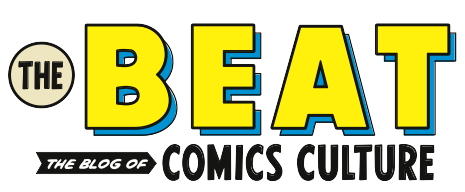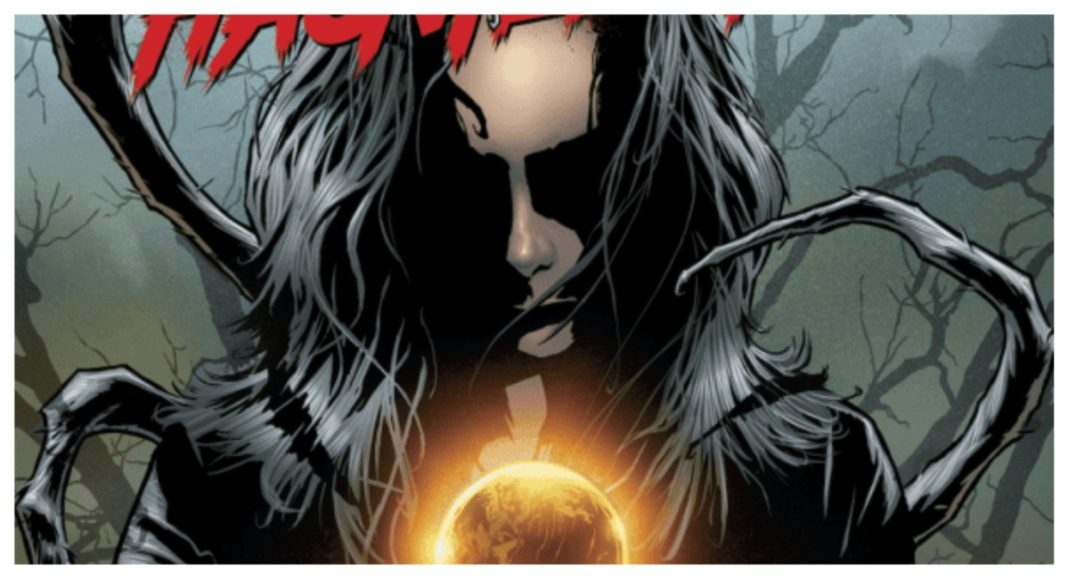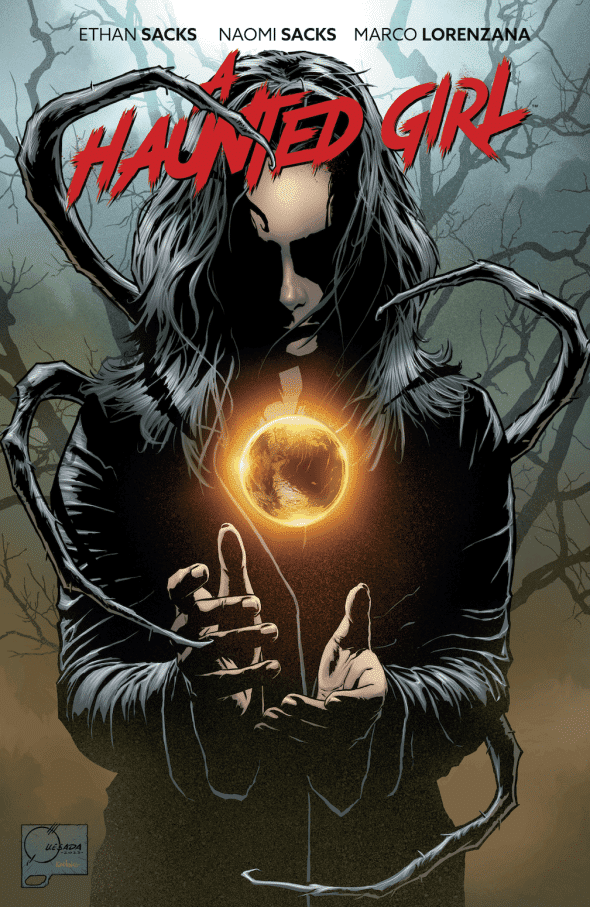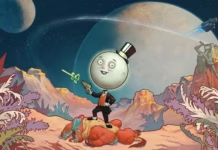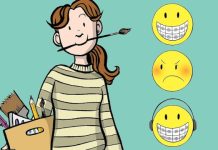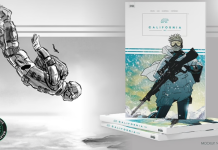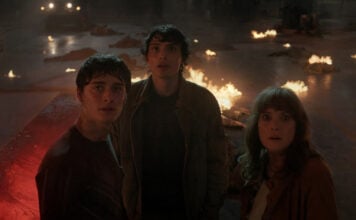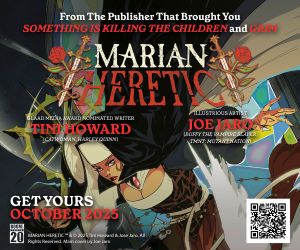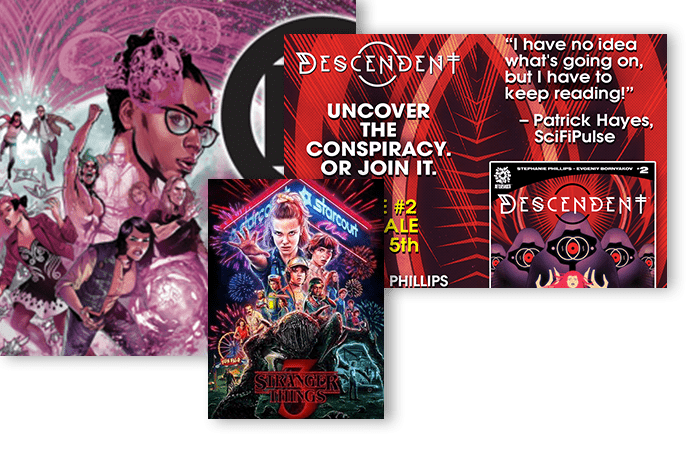Writers Ethan Sacks (Star Wars: Galaxy’s Edge, Old Man Hawkeye) and his daughter, Naomi Sacks are teaming up once again to release an exclusive extended hardcover edition of their critically acclaimed supernatural series A Haunted Girl—this time through Zoop. The campaiogn launches today during World Mental Health Awareness Month, and a portion of the proceeds will go to the American Foundation for Suicide Prevention.
The story of a teen girl who is battling depression, suicidal ideation and perhaps supernatural threats, it is based on real life experiences of the family.
The Beat spoke with the co-writers ahead of the campaign launch to talk about how this mental health-driven story evolved from a personal crisis into an emotionally resonant comic—and how they’re giving back through the new edition.
DIEGO HIGUERA: This story clearly comes from a deeply personal place. What was it like turning something so raw and real into a supernatural narrative?
ETHAN SACKS: So, before Naomi joined, the basic idea came at the beginning of her first hospitalization—one of three in 2019. I knew I wanted to write a story that might inspire her and others going through a suicidal or depressive crisis to find a path toward wanting to live. I had worked with artist Marco Lorenzana before on a creator-owned project called Intrusion. It took so long to get this new project up and running that, by the time we really got moving, Naomi was already in a better place. That shifted everything. When it was just Marco and me, we had a supernatural concept and a vague idea of a character—but it was two-dimensional compared to what Naomi brought to it. She breathed life into the character and the experience. All the therapy scenes, the hospital moments—that came from her. The real emotional rawness came from her, so I’ll let her speak to that.
NAOMI SACKS: It was definitely a bit intense. I knew I wanted to draw on my past experiences. At that point, it had been a few years since the hospitalizations, which were the most intense part. When you’re not consciously thinking about it on a regular basis, it’s not really a thing. But going back into those memories, it was intense again. I forgot how intense it was when I experienced it. I definitely needed to take breaks at times. It’s a bittersweet feeling, realizing how intense it all was and how I went through that. I’m in such a different place now, and it puts things in perspective. In a way, it’s like experiencing similar things again while writing about them, but with a bit more distance. It was definitely an interesting experience. I tried to be as accurate to the feelings as possible. Through the dialogue, I felt I could convey what I couldn’t properly explain at the time. I leaned into those feelings, and there was something very therapeutic about expressing them in new ways.
HIGUERA: That’s awesome. That’s fantastic to hear. I was going to say—it was very accurate to my own experience, even before I knew the full story behind it. I remember thinking, “Hey, they know about grippy sock vacation. That’s crazy.” You could tell there was real love and effort put into it. You actually knew what you were talking about, and that came through. It was therapeutic, but also really impactful for the reader, because it immerses people in the story in such an honest way.
ETHAN SACKS: Her. I brought a bit of the adult perspective—the NPCs, if you will—like the adoptive father, the teachers, and characters like that. But the first-person experience? That was all her.
HIGUERA: Fantastic. That’s okay—I completely understand. Jumping off of that, I have to ask: A Haunted Girl feels both intimate and epic. How did you balance the emotional core of Cleo’s journey with end-of-the-world stakes? Because it’s one thing to take real-life experiences and then add spirits into the mix.
ETHAN SACKS: Yeah. There were two main reasons I wanted to do a supernatural story, even before Naomi joined. Number one: I needed a plot device that would make the main character have to be the one who solved the problem. The Chosen One idea sort of Buffy, Luke Skywalker. I won’t say Harry Potter, but that kind of thing. It had to be her. It couldn’t be something like, “Oh, I don’t feel like it someone else can step up.” Originally, I was toying with an alien invasion or something like that. But with supernatural, the great thing is, as a storyteller, you can make the rules of the world and its magic.
That was one reason. The other was, I wanted to deal with some really intense real-life themes but with a bit of a cushion. The fantasy element protects the reader a little, so it’s not as triggering as it might be if it were a gritty, realistic depiction of what someone goes through without the ghosts and such.
So that was the double reason. Plus, Marco and I love horror. Naomi has come into that as well. Marco Lorenzana, our artist and the third part of our creative trio, is based in Mexico and is a huge fan of Japanese horror movies. So the aesthetic-The Grudge, The Ring, Pulse that kind of feel is very much in the DNA of the book. Naomi is half Japanese, and Cleo is half Japanese, so that was another reason for that element. We wanted Naomi to recognize herself in the character. All of that started falling into place before she officially came aboard..
HIGUERA: What was the collaborative process like for you two, especially as father and daughter dealing with such a heavy subject?
NAOMI SACKS: I’ll be honest, we’re both very headstrong people, so I thought we were going to butt heads a lot. When I was first invited aboard, I expected to play more of a passenger-side role. That was just what I imagined going in. He has more experience in comics, but I was pleasantly surprised. It felt like a very equal partnership, and we didn’t butt heads much at all. It felt like we were able to work things out pretty easily.
At the beginning, we definitely had very distinct parts of the script that we worked on. My dad was more on the supernatural side—I always joke, internal demons versus external demons. I worked more on the therapy scenes and the dialogue, and he handled the supernatural stuff. That was especially true in the first script, since I was really new to scriptwriting.
I was new to the comic script format, and I was very intimidated by it. So at first, my dad gave me little dialogue blocks that I could fill in with my own lines. There was one two-page therapy scene I was supposed to do from start to finish, and I kept putting it off. Eventually, we agreed to do it together. He walked me through the process on how to find different angles and approach the scene.
It was definitely a learning curve. Looking back at that first script, I realize how much excessive detail I put in. I remember thinking, “Yikes—poor Marco.” But it wasn’t like, “This is my part, that’s Dad’s part.” We talked everything through. We both read over each other’s sections, and even though we started working on different parts, it all got smoothed over by both of us. I don’t think it reads as patchworky, I think it flows pretty smoothly throughout.
ETHAN SACKS: For the first issue, because I knew the format was new to her, I left two blank pages for Naomi to do from start to finish. In the second one, there were more pages. By the third issue—just for context, the story was originally released in four parts before it was collected in a trade and she was doing about two-thirds to 75% of it, working off the outline we had developed together.
She handled most of the third issue. I took on a bit more of the final one, just because it was more action-heavy and involved figuring out the climax; how many panels we had, pacing, that kind of thing. So I took the lead on that. But a lot of Issue #3 was mostly her, and I’d say Issue #2 was pretty evenly split between us.
HIGUERA: What was it like working with Marco Lorenzana to bring Cleo’s world to life in A HUANTED GIRL?
ETHAN SACkS: He came with his girlfriend to New York Comic Con in 2023, which was the week we were launching the book—so the timing was perfect. We had a signing, and Joe Quesada—who’s not only a friend but also did the Cover A for the first issue and gave us the artwork for free to support the mission we’re trying to accomplish.
Marco is someone I’ve known for years. He was actually the artist on the very first professional comic story I did, back in 2017.
It was an eight-page anthology story for Secret Empire called Brave New World. Maybe ten pages total. And Marco said, “I’d like to work with you again—let’s find something.” We ended up doing a creator-owned book called Intrusion, which was a horror story. So I’ve known him for a long time, and I love working with him.
He was also incredibly patient. This idea first came to me in 2019, the gem of the idea, at least. He worked on character sketches, we put together a pitch, a sample scene, and all that. But we didn’t actually get approval until late 2022 from Chris Ryall at Syzygy, an imprint of Image. There were a lot of no’s along the way. We even had to turn down one deal, which was scary at the time.
But through it all, Marco was patient. He was doing all this work without knowing if we even had a publisher. We always say it’s the three of us—Naomi’s story, my role as her father and co-writer, and Marco. The origin of the book gets a lot of attention, but Marco is an equal part of this. It’s really a power trio.
HIGUERA: Mental health is central to A Haunted Girl, and with the campaign launching during Mental Health Awareness Month, what do you hope readers take away?
ETHAN SACKS: So what we’re doing with this Zoop version, this extended hardcover edition, is adding a lot of material we couldn’t include the first time. For example, there’s the People Magazine feature. Marco did a step-by-step “How to Draw Cleo” feature. We’re including excerpts from the script, layout pages, and finished art. It’s a more complete package and something we’ve wanted to do for a while.
The other part, and I think the major part, is that we can finally do something where part of the proceeds go to the American Foundation for Suicide Prevention. Dating back to the original release, both AFSP and the American Psychiatric Association did sensitivity reading for the book and contributed resource guides at the back. That was really important to us. We wanted anyone who read it—especially if it resonated with them—to have somewhere to turn or something they could do, and not just walk away with, “Hope you liked it.” We included everything from the crisis hotline number to free programs they could find online.
AFSP was a major part of that, and this is a cool way we can give back. That wasn’t something we could do before, either afford to or logistically manage in the initial Image run. There were just too many steps we had to get through just to publish it. But with Zoop, because we’re the ones handling it, we can finally do that. That means a lot to us, and we hope we can raise some kind of money that’s tangible and helpful to them.
NAOMI SACKS: I guess I just hope that when I was going through it—everything from hospitalization to reintegrating back into school—it all felt like this big unknown. You hear a lot of people say, “Mental health matters,” and I think that’s great, but we don’t often see what mental health support actually looks like in a concrete way.
So it was important to me to try and demystify it a bit. Obviously, Cleo has more ghosts and supernatural demons than the average teenager, but I also wanted people to see: this is what it can look like. It’s not elegant. It doesn’t go from hospitalization to “Great, Cleo’s back in school and thriving.” It’s not like that.
It’s awkward and clunky at first. She’s trying to get used to the rhythm of life again. But she works through it. It’s not perfect. She still has a lot to work on, but she gets there. I hope it helps people see that mental health recovery is messy, but possible. I hope it makes the whole process feel a little more real and relatable.
HIGUERA: Anything you want readers and fans to know?
ETHAN SACKS: We definitely encourage people to check out the Zoop campaign once it launches. There are going to be lots of add-ons, so for comic fans, I hope there’s some cool stuff in there. It’s obviously an important project, and whatever I personally got from this, I’m putting 100 percent into the making of A Haunted Girl 2.
We’re doing a sequel, basically a graphic novel, set a few years later. It’s an ensemble story in which a new generation of teens who are hospitalized and going through their own mental health struggles. That allows for more diversity, not just in the cast but in the range of experiences being explored.
Cleo is actually there eight years later as a psychology resident, working in the same hospital where she was once a patient. We wanted to show two things: first, we didn’t want her to become a superhero who solves every new monster situation. We wanted her to be more like a Yoda figure, a mentor. At the same time, we wanted to show her growth. She’s in a better place eight years later, but still working through things like we all do.
I like to say there’s no such thing as normal, only an average. We consider normal to be the midpoint of everyone’s struggles. So we wanted to take the mythology in a new direction and expand it. We’re really excited about that. We’re just getting started, and one of the things the Zoop campaign will do is help get that off the ground.
This was a story that we were very lucky to have Chris Ryall, Syzygy, and Image, the overall publisher, take a chance on. It touches on some very tough subjects that not every publisher would feel comfortable addressing. It was a real leap of faith that they did it. It’s also so personal for us, so we’re really grateful that it seems to have found an audience and that people genuinely care about it.
If you’re interested make sure to check out the campaign, it launches today and is much more than a comic- it’s a lifeline. Its raw and honest with a supernatural edge and real world experiences. This new edition is worthy of your attention so make sure to head over to Zoop to be a part of the campaign.
If you or someone you know are in emotional distress or crisis, reach out to the 988 Crisis Lifeline by calling or texting 988 or visiting 988lifeline.org/chat.
